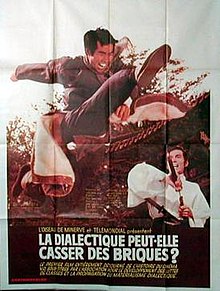| This article needs additional citations for verification. Please help improve this article by adding citations to reliable sources. Unsourced material may be challenged and removed. Find sources: "Can Dialectics Break Bricks?" – news · newspapers · books · scholar · JSTOR (April 2019) (Learn how and when to remove this message) |
1973 French film
| La dialectique peut-elle casser des briques ? | |
|---|---|
 Movie poster Movie poster | |
| Directed by | René Viénet |
| Starring | Jason Pai Piao Chen Hung-Lieh |
| Release date |
|
| Running time | 90 minutes |
| Country | France |
| Language | French |
La dialectique peut-elle casser des briques ?, in English, "Can Dialectics Break Bricks?", is a 1973 Situationist film produced by the French director René Viénet which explores the development of class conflict through revolutionary agitation against a backdrop of graphic kung-fu fighting.
The film utilizes footage from the 1972 martial arts film Crush by Tu Guangqi, which tells the story of anti-colonialist revolt in occupied Korea, which was dubbed over by the filmmakers in an example of détournement. Viénet's intention was to adapt a "spectacular" film typical of the film industry to the purposes of a radical critique of cultural hegemony and thus an expression of subversive revolutionary ideals.
The narrative focuses on a conflict between proletarians and bureaucrats within state capitalism. The proletarians enlist their grasp of dialectics in the fight against their oppressors, while the bureaucrats defend themselves using a combination of co-optation and violence.
The film also contains numerous references to socialists, including Karl Marx, Bakunin, and Wilhelm Reich, as well as scathing criticism directed toward the French Communist Party, trade unionism and Maoism. Subplots dealing with issues of gender equality, alienation, the Paris Commune, May 1968 and situationist politics itself are riddled throughout the film.
The film has been compared to La Chinoise by Jean-Luc Godard, due to its usage of anti-capitalist political theory and Chinese imagery.
According to Richard Metzger, of Dangerous Minds, the film is a “a critique of class conflicts, bureaucratic socialism, the failures of the French Communist Party, Maoism, cultural hegemony, sexual equality and the way movies prop up Capitalist ideology.”
The Situationist movement argued that the persistence of capitalism relied on the system turning lived experiences into "anaesthetizing ‘spectacles’ that perpetuated alienation." Viénet's layering of radical Marxist discourse over a martial arts film delivers political messages through the use of humour as a way of "forcing audiences to actively confront the mechanics of their own entertainment."
The film is one of the few remaining examples of a situationist use of cinema, since Guy Debord withdrew his films from circulation.
References
- Marshall, Colin. "Radical French Philosophy Meets Kung-Fu Cinema in Can Dialectics Break Bricks? (1973)". Open Culture. Retrieved 1 November 2022.
- Metzeger, Richard (21 February 2012). "CINEMA SUBVERTED IN 'CAN DIALECTICS BREAK BRICKS?' (1972)". Dangerous Minds. Retrieved 1 November 2022.
- ^ ""Can Dialectics Break Bricks?" by René Viénet, 1973 CE. | the Core Curriculum".
- "UbuWeb Film & Video: René Viénet - Can Dialectics Break Bricks? (1973)".
External links
- Can Dialectics Break Bricks? at 0xDB
- Can Dialectics Break Bricks? at Douban (in Chinese)

- Can Dialectics Break Bricks? at UbuWeb
- Can Dialectics Break Bricks? at IMDb
This article related to a French film of the 1970s is a stub. You can help Misplaced Pages by expanding it. |
This article about critical theory is a stub. You can help Misplaced Pages by expanding it. |